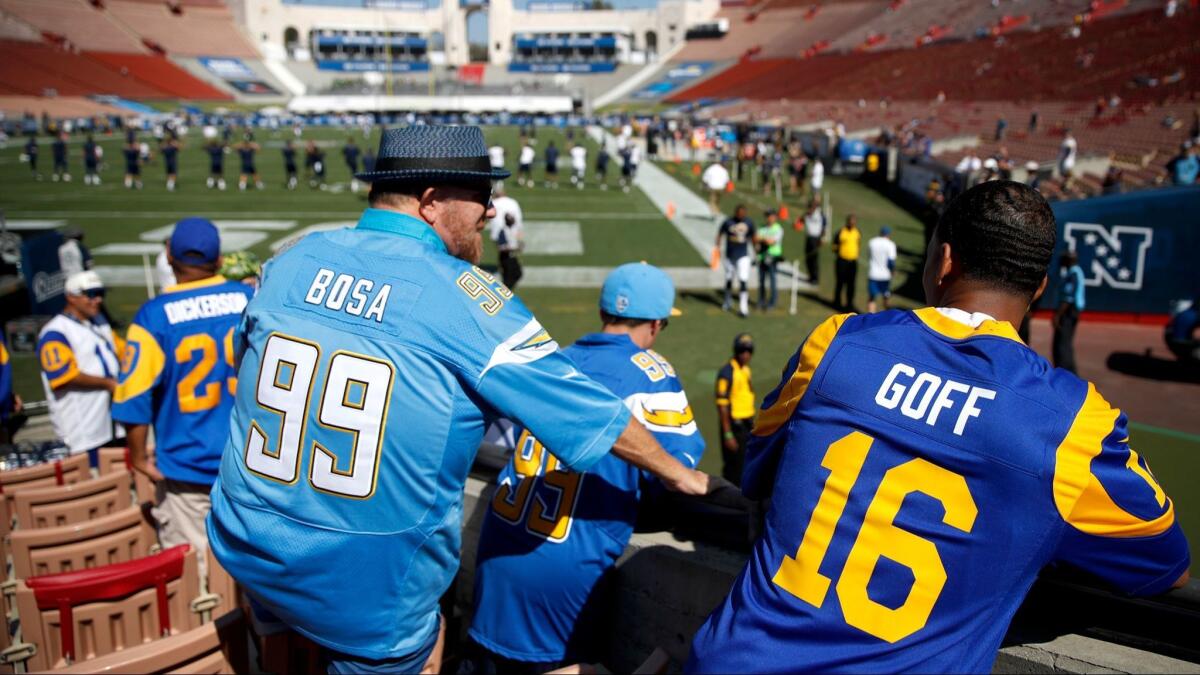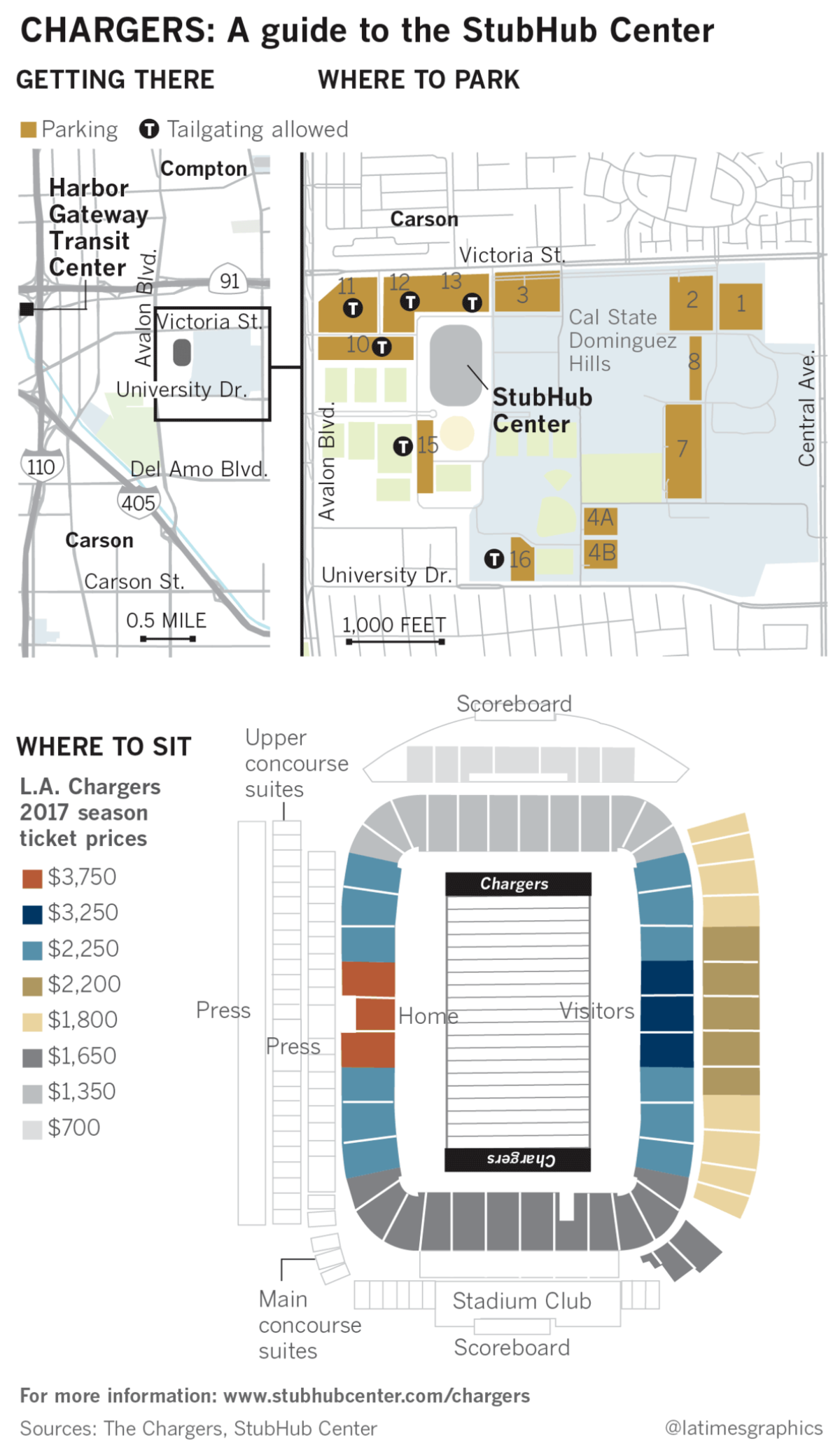Fight for L.A. is a market share program

It was only a preseason game. The final score didn’t count in the standings and the Coliseum, at first glance, could not have been more than half-full on a warm, drowsy August afternoon.
None of that stopped the Rams fans in attendance from standing and booing as that other team from across town — the Chargers —trotted onto the field before kickoff.
The stadium’s public address system blared a 1970s hit song by the band War: “Why Can’t We Be Friends?”
The fans kept booing.
::
Not since the early 1990s, when the Rams and Raiders played here, have two NFLteams attempted to share the Los Angeles metropolitan area.
This time feels different if only because the Chargers and Rams have arrived within a year of each other, both starting over in a city that serves as a blank slate. There is the potential for a budding rivalry.
The teams have done their best to dismiss any suggestions of crosstown rancor. Though the Chargers have adopted “Fight for L.A.” as their motto, they insist it is nothing personal.
“It’s just there to sell tickets,” nose tackle Brandon Mebane said.
Still, football is a competitive business.
Players scuffled when the teams practiced with each other in training camp this summer. Their preseason game last month had some heated moments.
As the booing continued, Chargers players held their hands to their ears and waved their arms, encouraging Rams fans to yell louder.
A crunching tackle along the sideline elicited gasps from the crowd. There was a string of penalties for unnecessary roughness and roughing the passer.
Off the field, the battle could become even tougher as the franchises wrestle for a slice of the same consumer base.
“This is about competing right now in a market with some very compelling competition,” said David Carter, executive director of USC’s Sports Business Institute. “Only one team is going to win this fight.”
::
Two weeks before the matchup at the Coliseum, the Chargers made their preseason debut 15 miles south in Carson.

It wasn’t like the Rams coming home in the summer of 2016, drawing almost 90,000 for a game against the
On a bright, sunny day — perfect for watching football — only 21,000 showed at StubHub Center, the undersized soccer venue that will serve as the Chargers’ temporary home for the next few seasons. There were thousands of empty seats.
Standing at his locker after the game, offensive lineman
The attendance figures did not seem to worry him.
“L.A. is one of the biggest cities in the world,” he said. “So I don’t think it will be a problem finding our fans.”
::
Playing in the country’s second-largest media market — even if you have to share it — has advantages.
Forbes’ recent list of the most valuable sports franchises estimated the Rams have doubled their net worth to $2.9 billion and the Chargers similarly have experienced a 36% bump to $2.08 billion.
“A race for L.A.?” asked Scott Minto, director of San Diego State’s sports MBA program. “More of a race to L.A., to make sure you get into that market.”
But even in a metropolitan area of 13 million people, it can be difficult carving out a place amid the cineplexes and amusement parks, the beaches and museums.
“Competing for the sports and entertainment dollar . . . it’s difficult for there to be enough shelf space,” Carter said.
The
The Rams not only got that one-year head start on the Chargers, but they also have a history with the city that dates to the 1940s and the days of Bob Waterfield and Elroy “Crazy Legs” Hirsch. The Chargers began life in L.A. in 1960 as part of the fledgling American Football League but played only one season in the Coliseum before moving to San Diego.
David Carter — not the USC professor, but a Rams fan with the same name — continued a family tradition when he bought season tickets to bring his son and grandson to the Coliseum.
“My dad and grandfather used to bring me to games here in the ’60s,” the 56-year-old from Beaumont said. “Of course I’ve stayed with the team.”

The Rams lost some of their initial momentum with a dreary 4-12 season in 2016. Still, it seems the Chargers are starting from behind.
Days after the team announced its move from San Diego, the crowd at a Lakers-Clippers game at
Chargers fans say L.A. can feel like enemy territory.
“A lot of my friends are Rams fans,” said Alex Hernandez, 25, a Chargers fan from Santa Fe Springs. “There’s always going to be more of them than us.”
::
A large blue sign over the peristyle end of the Coliseum read: “Whose house?”
As the Rams and Chargers got started, it was the visiting team that answered first. Veteran quarterback
Near the end of the first quarter, the Chargers took a 21-0 lead on a short touchdown run by Melvin Gordon. Their fans, though clearly outnumbered, were making the most noise.
“This is a business where you compete,” Chargers safety Jahleel Addae said. “There’s a winner and a loser . . . you want to come out on top.”
::
The fight for L.A. starts — of course — on the field.
“What does it take to win the fans?” said Mebane, who grew up here. “You’ve got to play winning football. You’ve got to take care of business.”
Rivers, Gordon and receiver
The Rams were dead last at 14 points a game. But their roster features two potential breakout stars in quarterback Jared Goff and running back Todd Gurley, which could make a difference.
“Having exceptionally marketable players is a big part of it,” Minto said. “You’re forging an identity with the city.”
Long touchdown passes and dazzling runs aren’t all that matters.
Much like the Clippers in Staples Center, the Chargers will be seen as a tenant when they move into the Rams’ new stadium in Inglewood. That could influence the battle for corporate sponsorships, advertising and merchandise sales.
In the short term, USC’s Carter talks about “relevance,” which he defines as the ability to win when it counts and generate enough buzz to be heard above a white noise that extends beyond pro football.
The Dodgers are making a historic run this summer. USC begins the college season with
“This is not a ‘just add water’ market,” Carter said. “Being famous for being famous doesn’t work in sports.”
Between the Rams and Chargers, the first team to string together a couple of winning seasons should gain an edge, sports business experts predict. But there is another factor to consider, something Minto refers to as an “ever-looming presence.”
The San Diego State professor is referring to a mass of fans left over from the Raiders’ stint here. Their team will soon relocate from Oakland to Las Vegas, a four-hour drive away.
At that point, the Southern California market will become even more crowded.
“Fans can go see their team and spend the weekend in Vegas?” Minto said. “Great.”
::
The Rams finally started making noise with three field goals in the second quarter. Then came a 38-yard touchdown pass after halftime. The crowd inside the Coliseum woke up.
“It was a decent amount of people here,” Rams defensive lineman
As the clock ticked down on a close game, a scuffle broke out in the stands. A man wearing a Chargers jersey was led away from a cluster of Rams fans by police. He hollered: “They don’t like the Chargers here.”
After the Chargers held on for a 21-19 win, both teams continued to downplay any crosstown animosity. “We’re in different conferences, different divisions,” Gordon said. “We’re too busy worrying about the
But Slauson wondered if L.A. fans will measure the Rams and Chargers against each other as the season progresses. And Rams offensive lineman Jamon Brown suspected some players also take an occasional peek at the standings.
“If it turns into a rivalry” he said, “that’s the way it is.”
Times staff writer Lindsey Thiry contributed to this report.
Twitter: @LAtimesWharton
Go beyond the scoreboard
Get the latest on L.A.'s teams in the daily Sports Report newsletter.
You may occasionally receive promotional content from the Los Angeles Times.








